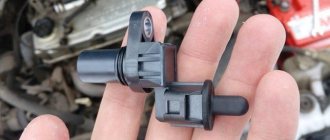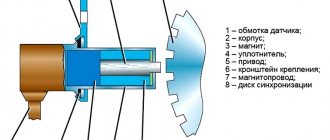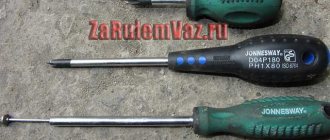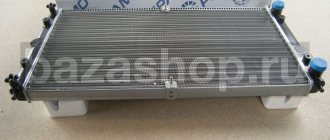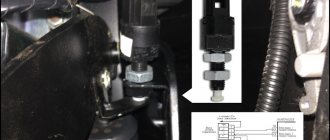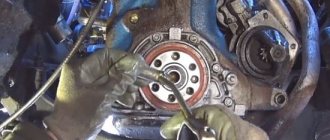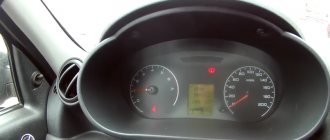Modern engines are controlled electronically; the days of mechanical adjustment of ignition timing and idle speed have sunk into oblivion along with carburetors and distributors. The Chevrolet Niva car is no exception: despite the rather “old” engines (in terms of manufacturability), the electronic control unit (ECU) is responsible for all issues of forming the fuel mixture and timely spark in the cylinders.
To receive real-time information from all systems, the power plant is literally studded with all kinds of sensors. One of them is the Niva Chevrolet crankshaft sensor (DPKV), which is typical for many engines developed by the VAZ concern.
How does he work
In order for the ignition timing to work synchronously with the movement of the pistons in the cylinders, information about the position of the crankshaft at each moment of time is necessary. There is a rigid mechanical connection between the connecting rods and the crankshaft: to track them, it is enough to read the angle of deviation of the crankshaft axis from the zero point.
For this purpose, a gear (58 teeth) is placed on the timing belt drive pulley. They do not participate in the operation of the timing pulley and are intended only for the crankshaft position sensor (CPS).
The position of these teeth is strictly calibrated relative to the entire timing system and piston connecting rods. The device itself is a Hall sensor with a permanent magnet that responds to the passage of a metal object in close proximity. That is, the rotation of the crankshaft with a gear generates a series of pulses on the sensor. As a result, the ECU receives data on the position of the pistons in real time.
How to replace the crankshaft position sensor on Lada 2123: photos and videos
The QG18DE crankshaft sensor is one of several sensor devices that ensure normal engine operation. DPKV transmits information to the vehicle’s on-board computer. The ECU uses this information along with signal inputs from other sensors to control ignition timing and fuel injection. This keeps the interaction of the motor parts timed and working in harmony.
The sensor wears out or fails over time. There is a possibility of damage to sensor parts such as wiring, gear, pin, magnet. In such cases, repair or replacement is required.
Crankshaft position sensor
What happens if the DPKV breaks down?
Signs of malfunction can be divided into two groups:
- The sensor has failed, so no pulses are received at all. In this case, the engine will simply stall, and you will not be able to start it until the breakdown is repaired. DPKV is the only sensor that, if it malfunctions, the internal combustion engine will not be able to operate even in emergency mode.
- The sensor malfunctions or provides incorrect information. The engine will start and run with obvious symptoms of a malfunction: loss of traction;
- power reduction;
- floating idle speed;
- The “Check Engine” warning light is on.
In addition, the engine may stall at any time for no apparent reason.
If you connect a car scanner to the OBD port, it will generate an error code 0335, which can be forcibly reset, but will appear again when the engine starts.
Characteristics of the camshaft sensor
The operating principle of this part is based on the Hall effect. What does this device do? The Chevrolet Niva camshaft sensor controls the gas distribution device and its tilt according to the crankshaft. The signal is received by a system that controls the flow of gasoline and the operation of spark plugs.
The operation of the camshaft sensor is based on monitoring the potential difference between the carriers of the amount of electricity, and its work is associated with another crankshaft position analyzer. The camshaft sensor operates under the influence of the Ampere force acting on a current-carrying conductor in a magnetic field. It uses a magnet to create a magnetic field, which changes under the influence of a special metal tooth on the camshaft wheel.
Thus, the part signals where the piston of the internal combustion engine cylinder is located, and the strokes of the cylinder operating cycle are carried out sequentially.
What happens if the sensor fails? The indicator turns on and the device that regulates the supply of the mixture of gasoline with air stops the dosed supply and the reserve mode is activated. Instead of sequentially supplying each cylinder according to its firing cycle, fuel is supplied to all simultaneously. Gasoline is used sparingly. In this case, the part is faulty and the owner should purchase a new sensor.
For each car, depending on the design features, the engine model, and its type, the sensor is located in different places. If you need to replace it, you should carefully study the engine diagram.
Where is the DPKV located, how to change it
The sensor is located near the timing belt pulley on the generator side.
A corrugated cable is stretched to its connector, the location is open, accessible from the engine compartment. The sensor is attached with one bolt to the crankcase body. Before removal, you must carefully disconnect the connector; dismantling other components is not required.
After removing the DPKV, you need to make sure that the contacts and the outside of the housing itself are clean. If necessary, clean and recheck the sensor.
If the symptoms do not disappear, the sensor must be replaced with a new one. The electronics inside the case cannot be restored.
An initial check is possible using a multimeter. A working sensor shows resistance at the contacts between 300 Ohm and 1 kOhm. When a metal object is brought to the end of the sensor, the resistance increases.
After installing the DPKV, no additional configuration is required. It is necessary to start the engine and let it idle for several minutes. Then the engine is turned off and started again. The sensor is calibrated by the ECU program automatically.
Trouble-shooting
So, the nature of the device malfunction and the reason for its occurrence have been determined. Now you can move on to fixing the problem. As a rule, repair work is quite simple and does not cause difficulties even for inexperienced motorists. But if you have any questions, it is better to contact the service center.
Elimination of minor defects in the operation of DPKV
Quite often, to ensure the normal functioning of the device, it is enough to eliminate only minor defects. Such work will eliminate minor interruptions:
Self-replacement
If repair work to eliminate minor defects does not produce results, the sensor must be replaced. You can perform the replacement yourself.
Preparatory stage
First you need to prepare the device itself, the working field, and the necessary tools. To replace the DPKV you will need:
Clean the work surface from dirt and oil deposits.
Removing the sensor
The space is prepared, now you can move on to the next step - removing the sensor. De-energize the device. Using a previously prepared wrench, remove the bolt that secures the device. Remove the sensor itself.
Rinse and dry the device thoroughly. Excess moisture can be removed with cotton swabs.
The drying temperature should not exceed 85 °C.
Next, measure the distance between the core and the timing disk. Check the results obtained with the data specified in the technical data sheet of the device. This distance must be maintained during installation.
Installation
Install a new device. It is recommended to use old fasteners to properly install the sensor in place. Do not overtighten the bolts to avoid damaging the housing.
Connect the DPKV to the network. Check its functionality.
The following tips will help you correctly install yourself:
Video on the topic
Good publicity
After the publication of my article on the topic of oil seals for the Niva, requests began pouring in to write the same regarding bearings and sensors for the 21214 engine, which is installed on Nivas, Niva-Ms, crocodiles and Shnivas. I’ll begin to slowly talk about “trouble-free” sensors, that is, those that you install and forget about for a very long time.
A few general words. Why did this question even arise? Let me give you an example: such garbage as a throttle position sensor (TPS). Since the electronics of our injector are taken entirely from their front-wheel drive counterparts, and their number is very large, a very large number of companies make spare parts for them, and there is no need to talk about the Chinese brothers at all. For some time I even saved up faulty TPS from different manufacturers in a box, after 7 I got lost and threw everything away)) While the factory supplies only two manufacturers.
Another example is the speed sensor. When it’s burned out, it happens that when driving through a puddle, the “check engine” lights up, or the engine simply starts to stall when coasting and nothing lights up. And when you reach the service level, like a wartime exterminator, suddenly the defect disappears. This means that water got inside the case and then also leaked out. So all is well......until the next puddle. One of the most basic sensors is the mass air flow sensor (MAF) , so a separate detailed article is devoted to it.
Chevrolet Niva 2021 controller
Chevy Niva has another upgrade. Starting from April 17, the GM-AvtoVAZ joint venture will begin producing modified SUVs, which, as standard, will have a system for automatically turning on low beams when moving (the car still does not have separate running lights), an updated instrument cluster with adjustable backlighting, as well as USB - connector for charging mobile devices in the tray between the front seats. And versions with air conditioning (only the base L trim lacks it) now have a cooled glove box.
The most expensive versions of GLC and LE+ have become even richer. The driver's seat now has height adjustment and a right armrest, which, when tilted back, turns into a drink holder. The rear windows are factory tinted, and the most unusual new addition is the rear view camera, which transmits the image to the display in the interior rearview mirror. Finally, the most off-road versions of the LE and LE+ now have a rear axle gearbox breather, designed to prevent possible water from entering the gearbox housing when fording.
Of course, the Chevrolet Niva has become more expensive. Versions L, LC, LE and GL have added 2000-5000 rubles in price: now they cost from 588 thousand, and the “base” still does not have airbags or ABS (all this appears starting with the GL configuration). Nivas in GLC and LE+ versions have become more expensive by 20,500 rubles: for them you need to pay 719,500 and 732,500 rubles, respectively.
Commercial firmware for Niva Chevrolet with ECU ME17.9.71 from Paulus
Crankshaft position sensor - DPKV
crankshaft position sensor
The task of this sensor is to read the revolutions of the engine crankshaft and whether it is spinning at all. Perhaps the only sensor that I recommend keeping in your car’s first aid kit (so as not to get lost) as a spare. This is the only sensor without which the injector will not start in principle. Without the rest, the engine will sneeze like a sick person, hiccup, fart, blink the check engine... but rattle. Which means it’s bad, but go. Without DC there will not even be signs of life. Therefore, we will consider it, in medical terms, as setting the heart rhythm. I’ll tell you a little secret, if you are leaving somewhere or leaving the car in a bad place, open the hood and slightly disconnect the DC connector. It is difficult to imagine a more effective anti-theft. The main thing is not to forget about it yourself))
Crankshaft position sensor design - few parts
This sensor is electromagnetic in principle. Thanks to it, the fuel injectors in the fuel injection system and the entire ignition system operate synchronously. This part is located on the bracket, next to the generator drive pulley. When installing it, maintain the gap between the toothed pulley and the sensor itself.
The size of this gap should be within 1 millimeter; this is achieved by selecting appropriate washers.
There are 60 teeth on the synchronization disk, with 2 of them missing, and the beginning of the twentieth coincides with the dead center (top) of the first or fourth cylinder. The design of the crankshaft position sensor assumes a gap between its end surface and the teeth of the disk. And it itself is presented in the form of a winding of copper wire and a magnetized core located inside it.
Throttle position sensor - TPS.
The function of this sensor is to provide information to the brain about the position of the gas pedal and the degree of throttle opening. The TPS contains electromechanical parts, that is, a potentiometer. This means that after some time it wears out and the sensor dies. In Russia there are about 10 companies producing this sensor. But I want to draw the reader’s attention to the so-called non-contact (inductive) TPS. It is made by one company, which used to be a “mailbox”. My experience has shown that the sensor in their “non-contact” design is virtually eternal. This is exactly what is shown in the photo.
Description of the camshaft sensor
The camshaft position sensor (CPS) is designed to monitor the position of the camshaft relative to the crankshaft so that the ECU can receive information about which of the engine cylinders is on stroke. Based on the information received, the operation of the fuel injectors and the supply of a spark to the combustion chamber are synchronized.
Common faults and solutions
A malfunction of the DPRV can be determined by the following signs:
- When the engine starts, the starter spins the flywheel for a few seconds. When the engine starts running, the “Check Engine” message appears on the dashboard. This means that the ECU is waiting for information from the device.
- Increased fuel consumption.
- During operation, an error appears during the vehicle's self-diagnosis.
- Engine dynamics drop.
- The engine does not start.
- The toxicity of exhaust gases increases.
Speed sensor – DS.
The brain uses the signal from the speed sensor to control the engine's idle speed. And support for “pickup” speed while the car is coasting. The actuator of this circuit is the idle air regulator, which controls the air supply bypassing the throttle valve. Enough theory, let's get closer to the people. In fakes based on this sensor, ahead of the original by an order of magnitude - the Chinese brothers. 8 out of 10 sensors that I held in my hands in stores and on the market were made in China. They work for three months, after which they announce their retirement as a “check engine.” What is the difference between the original and the pale one? In the photo, I indicated with arrows where the wires entering the connector are filled with varnish. The seam of the body, which consists of two parts, is also filled with varnish. Mao's heirs consider this unnecessary, and that is why the sensor dies after the onset of the first St. Petersburg slush.
How does the sensor work?
To learn how to troubleshoot the specified device, you need to understand its design and understand the principle of operation. The sensor design is simple and includes the following elements:
- multi-turn coil;
- magnetic core;
- the coil leads are soldered to the connector contacts;
- non-separable plastic case with a hole for fastening.
The meter is installed in close proximity to the toothed pulley attached to the crankshaft on the timing gear side. Through conductors, the sensor is connected to the main electronic unit that controls the operation of the motor.
The magnetic core is brought out through the end part of the plastic case and is as close as possible to the teeth of the rotating pulley. The gap between the parts does not exceed 1 mm.
The operating principle of the device is based on the phenomenon of electromagnetic induction . When a significant mass of metal passes in close proximity to the core, the coil generates a short-term electrical impulse. The teeth of the rotating pulley cause a series of such impulses, transmitted through the wires to the controller. Thanks to this, the electronic unit always “knows” the position of the crankshaft, determines the top dead centers of all pistons and promptly sends a command to the injectors to inject fuel.
This is where the second name of the device came from – crankshaft speed sensor. It must be understood that impulses are generated only under the dynamic influence of the metal mass, that is, when the pulley rotates. If the crankshaft has stopped, no current occurs in the element circuit.
Note. Based on sensor signals, the controller not only promptly directs the fuel mixture to the cylinders, but also commands the ignition system to produce a spark when one of the pistons performs the compression stroke and approaches its top point.
Phase sensor - DF
It's also a camshaft sensor. The VAZ phase sensor is designed to determine the angular position of the camshaft. The main function is that when the engine is running, the phase sensor provides a pulse signal to the controller synchronizing fuel injection with the opening of the intake valves. Failure of the phase sensor switches the fuel supply to pairwise-parallel mode, which leads to a slight (up to 10%) increase in fuel consumption. And I’ll also add this “miracle of nature” is a headache and a source of a lot of errors, for example the famous 0301, 0302.... In my humble opinion, this is the same disgusting and abomination as the old-style hydraulic compensators. But what has grown has grown. (How to get rid of it forever, lambda, roll sensor - will be written in the article about chiptuning). The only normal manufacturer of this sensor is Avtovazagregat. The logo is visible in the photo.
The crankshaft of a car is used to convert the translational motion of the pistons into rotational motion. On technical equipment with an electronic engine control system, a crankshaft position sensor (hereinafter referred to as CPPS) is installed. The controller is necessary to synchronize the ignition angle and the fuel system.
In the event of a malfunction of the equipment, a yellow indicator on the dashboard indicates the presence of a breakdown. The engine is unstable, idle speed is systematically reduced, power drops, and fuel consumption increases.
Replacing the sensor
If a malfunction is detected in the operation of the knock sensor, the owner of the Niva-21214 must begin repairing or replacing the device. You can perform the procedure yourself by deciding where the sensor is located and preparing the necessary tools before starting work. These include:
- screwdriver;
- wrench;
- 13 mm head.
You will also need to stock up on a new knock sensor.
The procedure for replacing the DD is as follows:
- The car owner places the vehicle in a convenient position for work.
- Turns off the engine and disconnects the terminals from the battery. This is necessary for the safety of further work.
- After this, you will need to remove the wire from the sensor and unscrew the bolt that secures it to the engine. The procedure is performed using previously prepared instruments.
- Once this is done, you can replace the old knock sensor with a new one. It will also need to be secured with a bolt (no need to tighten it too much) and a terminal attached.
- The final step involves reassembling the car structure in reverse order.
After the procedure for replacing the knock sensor is completed, the owner of the Niva-21214 will need to start the engine several times to check the functionality of the sensor and the entire car as a whole. First of all, you should pay attention to the symptoms of breakdown that were indicated above. Naturally, they shouldn't exist.
Based on this, we can conclude that the process described above is not complicated, and to replace the sensor it is not at all necessary to contact a service station. However, in order to protect yourself from possible malfunctions, you should regularly diagnose and maintain all components of the car.
Lada Kalina, Vesta, Granta, 21214 or a classic car 2107 - the principle of replacing the DPKV is the same. It is enough to unscrew the holding bolt from the bracket, disconnect the connector from the wiring harness and remove the sensor.
Over time, the wires going to the DPKV chip wear out. Located in the lower part of the engine and not far from the front wheel, as a result, dirt, snow, oil, and aggressive chemical media in the form of salt get on the DPKV and its chip and settle, which leads to slow oxidation of the wires on the chip and subsequently to their breakage.
From the diagram below it can be seen that their pinout is not complicated and two wires are directly connected to the signal input contacts in the control unit, passing along the entire length of the harness. The polarity of the connection between the signal wires of the sensor and the control unit must be observed. If the polarity is reversed, the synchronization system will not work. To restore the operation of the DPKV, you simply need to swap the wires and check the functionality by starting the engine.
Description
Where is the DPKV located on a Niva Chevrolet: in the engine compartment, at the end of the engine, above the crankshaft pulley.
Access to the equipment for carrying out maintenance from below, having previously dismantled the metal protection of the oil pan.
DPKV transmits signals to the electronic control unit (ECU) in real time and also reports the direction and speed of the crankshaft.
Based on the data received, the ECU makes a decision to reduce or increase the frequency, enrich the fuel mixture, or change the ignition angle.
Note to the driver!!! Depending on the technical characteristics of the car, brand, modification, DPKV of magnetic, inductive type, Hall sensor, and optical controllers are preinstalled.
9.7.6 Crankshaft position sensor: general information, removal and installation
Turn off the ignition and connect its electrical wiring to the sensor. Connect the positive probe of the voltmeter to the terminal of the black wire on the back side of the connector. For more details, see Chapter On-board electrical equipment. Ground the negative probe to ground.
replacing the knock sensor on a Chevrolet Niva
Momentarily touch the sensor tip with a metal object such as a screwdriver. At the moment of contact, the voltmeter should register reading 5. When the metal is removed, the signal amplitude should quickly drop to zero.
Tags: corsa, Opel, station wagon
- Related Posts
- replacing the cylinder head gasket Niva Chevrolet • Chevrolet Niva
- Changing the engine oil - Hyundai Accent logbook >> years on DiabloArea
- Replacing the standard radio on a Renault duster - Forum about Renault Duster (Renault Duster)
« Previous entry
Symptoms of DPKV malfunction
- Difficulty starting the engine “hot” or “cold”;
- When moving downhill, detonation occurs;
- Idle speed is unstable;
- Motor power decreases periodically;
- Acceleration dynamics are passive;
- Sudden engine stop.
However, these symptoms are signs of a number of other breakdowns. It is extremely important to conduct comprehensive diagnostics using digital equipment.
| Name / catalog item | Price in rubles |
| VAZ 21214-2123 OMEGA 173882 | From 350 |
| 2112-3847010 | From 350 |
| 21120-384701004 | From 350 |
| 21120-384701036 | From 350 |
Causes of premature wear of the DPKV
- long-term operation without intermediate prevention;
- manufacturing defects;
- third-party mechanical damage;
- ingress of sand, dirt, metal shavings;
- sensor breakage due to crankshaft teeth;
- damage to the DPKV during repair work;
- short circuit in the on-board circuit.
In the Niva Chevrolet, the speedometer needle is driven not by a cable and a magnetic device, as in classic VAZs, but by electronics. The speedometer itself, like the rest of the instruments on the panel, are nothing more than voltmeters or ammeters with different scales.
The speedometer receives an impulse from the speed sensor, and it is installed on the transfer case housing. These impulses are also monitored by the electronic engine control unit and, receiving them, draws its conclusions about the operating mode of the motor.
The signs of a non-working speedometer are quite clear - the needle either lies shamelessly, showing 160 at a speed of 20 km/h, or twitches, or falls dead to the zero mark.
Since there are not many elements in the electrical circuit of the Chevrolet Niva speedometer, there are only a few reasons for the device not working:
- Mechanical damage to the speedometer itself.
- No contact in any of the terminal connections.
- Broken or shorted wire.
- Failure of the speed sensor.
- ECU malfunction.
Step-by-step instructions for self-diagnosis
To check the condition of the DPKV we need a multimeter. The measuring device is available to many car enthusiasts. If you don't have it, you can purchase it at any auto store. The price is affordable.
- From under the bottom of the car, disconnect the terminals from the sensor.
- We bring the limit switches to the contacts;
- Turn on the multimeter, set the position of the regulator to “resistance”;
- We carry out actual measurements;
- We compare the obtained data with standards. If the arrow tends to infinity, the controller is working. If it goes to “zero”, it’s a breakdown. Normally, readings should be 550-750 Ohms.
Depending on the diagnostic results, the technician makes a decision on the advisability of further operation of the equipment.
How to test a sensor using an ohmmeter
This method is the simplest, but it does not guarantee detection of a breakdown. The resistance of the crankshaft sensor winding can be measured with a multimeter by switching it to ohmmeter mode. For a working sensor, its value is 550-750 Ohms.
When checking with a multimeter, the resistance of the inductor is determined, since if there is damage in it, the characteristics of the sensor will primarily affect the resistance. First you need to set the desired range of values. The upper limit of resistance is usually 2 kΩ. After this, a test is performed with probes on the terminals. The resistance value should be 500-700 Ohms, but to be completely sure, it is better to carefully study the instructions for the machine and clarify this value. If the obtained numbers correspond to those indicated in the documents, then at this stage the coil can be considered serviceable, that is, you can proceed to the following verification methods. If the obtained indicators do not correspond to the interval declared by the manufacturer, the crankshaft speed sensor will have to be replaced.
A sensor can malfunction or even fail for a variety of reasons. Often, the most common dirt adhering to the DPKV can cause data reading errors.
- Unstable operation at idle.
- Spontaneous increase and decrease in power unit speed.
- Reduced engine power.
- During acceleration, “dips” appear.
- The car is difficult to start.
- As a rule, in such cases, the only way out is to replace the DPKV.
- If error 0335 or 0336 appears, then in this case with a high degree of probability it can be stated that the wire near the connector is broken. In this case, you just need to replace the connector.
Oscilloscope reading of the crankshaft sensor
- Physical damage to the case.
- Short circuit of the winding turns as a result of which incorrect data is transmitted to the control unit.
- Wear.
- Damage to pulley teeth.
How to replace the Niva Chevrolet crankshaft sensor yourself
Required materials and tools:
- key to “10”;
- head, knob, knob extension;
- rags;
- additional lighting as needed;
- new DPKV;
- Phillips head screwdriver.
Regulations:
- place the car on the inspection channel;
- secure the wheels with wheel chocks;
- squeeze the parking brake;
- from under the bottom of the car, unscrew the six bolts that secure the metal protection of the oil pan;
- Using a screwdriver, carefully pry up the block with terminals, remove it, and move it to the side;
- Unscrew the screw - the retainer from the sensor;
- remove the controller;
- We carry out troubleshooting of the seat, wipe it, clean it from residual dust and dirt;
- insert a new controller;
- screw it in and assemble the structure in reverse order.
DIY replacement completed. For a detailed step-by-step guide, watch the video.
Methods of checking in garage conditions
When your car's engine suddenly "dies", you need to remove the sensor and perform the diagnostics described below. If the motor continues to operate with signs of instability, perform the following manipulations:
- Thoroughly clean the device body with a rag moistened with an organic solvent - white spirit, turpentine or other degreaser. Pay special attention to the end facing the toothed pulley.
- Make sure the fastening is secure. Due to a loose screw, the sensor may move away from the metal teeth, as a result, the gap will increase and the generated pulse will weaken.
- Clean the connector contacts from oxidation.
- Inspect the wiring for melting or breakage.
If the above actions do not produce results, the crankshaft sensor is dismantled and checked with a multimeter in 2 stages. At the first, the resistance between the terminals of the device is measured, which makes it possible to verify the integrity of the induction winding. Clean the contacts, turn on the ohmmeter and check the resistance between them. Normal readings are in the range of 500–700 Ohms; if the turns are shorted, you will get a zero or reduced value; if there is a break, you will get infinity.
At the second stage, the performance of the element is tested according to step-by-step instructions:
- Switch the multimeter to voltage measurement mode, the maximum threshold is 200 millivolts.
- Securely attach the wires to the contacts of the sensor block (for example, with alligator clips).
- Take any metal tool - a wrench, a large screwdriver or something similar. Apply and tear it sharply from the magnetic core of the element, holding the body with your hand. The voltmeter should show voltage surges.
Advice. If the crankshaft sensor is OK, check the wiring with an ohmmeter. Perhaps the reason lies there.
Further actions are as follows: the broken crankshaft speed meter is replaced with a new one; the part cannot be repaired. The working sensor is installed back, maintaining the gap, and the troubleshooting continues in another place.
A few words about how to check the crankshaft sensor on the road when you don’t have a multimeter or other diagnostic tools. You will need 2 wires and an LED light bulb from any car lamp (for example, an interior lamp). For convenience, unscrew the element and connect the lamp to the connector, then apply a wrench to the magnet, as described above. A working sensor will cause the LED to flash.
Recommendations for care and maintenance of the controller
- strictly comply with the car manufacturer's regulations;
- do not violate the terms of technical inspection, even when the factory warranty has expired;
- buy and install mainly original parts, the catalog numbers of which correspond to the factory markings;
- Carry out the installation work yourself if you have sufficient experience, otherwise use the services of professional workshops;
- Do not install parts or accessories from other technical equipment, even if they are similar in appearance. Full functionality is not always guaranteed.
The average service life of the DPKV is 80,000 km or more.
To synchronize the position of the shaft with the electronic unit, the design of the Niva Chevrolet car is equipped with a crankshaft position sensor. This device is located not far from the drive disk, and is located on the timing cover of the mechanism drive itself. This disc is a wheel with fifty-eight teeth, and to create a certain impulse between the TDC (top dead center) and the ECU, a couple of teeth are specially removed.
Due to the fact that the crankshaft rotates, the drive disk rotates. The position of the ECU shaft is determined due to the fact that during the rotation of the disk at the sensor, magnetic fields change, thereby forming an alternating current pulse.
DTOZH
The coolant temperature controller is also considered an engine temperature sensor. This device is a resistor whose resistance value changes in accordance with the temperature of the consumable.
If you are wondering where the DTOZH is located, it is located on the coolant exhaust line, directly on the cylinder head. If the air temperature outside is negative, the resistance of the sensor will be increased - at 40 degrees below zero this figure will be about 100 kOhm.
When the motor warms up to operating temperature, the resistance will drop to 177 Ohms.
When the device fails, the dashboard will display incorrect readings regarding engine temperature. For example, the pointer needle may not rise at all, sometimes it stops in the middle of the scale.
To diagnose and replace the DTOZh, follow these steps:
- To begin, prepare a thermometer that can operate at high temperatures, a multimeter for testing, and a container of liquid that you will heat on the stove.
- Remove the sensor itself from the socket, having first disconnected the connector and placed a container under the location, since some of the antifreeze may come out during removal. Disconnect the connector and unscrew the device; temporarily install a plug in its place.
- Place the sensor in a container with water prepared in advance, only lower the part of the controller that was screwed into the cylinder head into the liquid. Measure the resistance and turn on the kitchen burner to heat the water.
- As the temperature increases, the resistance will drop. Measure this parameter several times at different temperatures, then compare the obtained data with the normalized ones indicated in the table in the service book. If the data is very different, replace the device with a new one.
Detonation
A knock sensor is used to detect vibrations or shocks present in the operation of a car engine. This device is mounted on the top of the block head, and the device is based on a special piezo plate used as a sensitive component.
If the sensor detects detonation while the car’s engine is running, then special pulses begin to form at its output, which will increase with the increase in detonation.
In accordance with these signals, the engine control unit automatically adjusts the ignition until the number of detonation flashes is reduced to a minimum.
If the controller breaks down, the engine will detonate, especially when the speed increases in a lower gear. If you check the ignition, you will find that everything is set correctly and there is no need to adjust the timing.
Replacement is simple:
- The power cable is disconnected from the regulator in the engine compartment.
- The device is removed from the landing site.
- A new controller is being installed.
Phase
camshaft position (camshaft position) or phase controller is a device used to determine the position of the camshaft. This controller ensures correct fuel injection into the injectors, so its operation is very important for the car.
The DPRV is located in the front of the cylinder head and if it fails, you can not only change it, but also try to clean it.
Failures may be indicated by symptoms such as difficulty starting the engine, increased fuel consumption, and decreased vehicle dynamics.
- Open the hood and disconnect the terminal from the battery.
- Using a 10mm wrench, unscrew the bolt securing the device.
- Remove the controller from its place and install a new one or clean the old sensor.
- Replace the bolt and tighten it, also reinstall the battery terminal.
Photo gallery “Changing DPRV”
Speeds
As the name suggests, the speed controller is used to determine the speed of the SUV. Various symptoms can indicate its breakdown, for example, a non-working sensor needle on the speedometer, its movement with jerks.
The sensor is located directly on the gearbox; you can check it using a tester:
- First, the controller is removed from its location; to do this, the car must be driven into a pit and the battery must be disconnected. The device is installed on the back cover of the transfer case; before removing, clean the controller from dirt.
- Disconnect the connector circuits connected to the device by pressing the plastic connector. Using a wrench, you need to unscrew the device and remove it.
- After this, you need to connect the positive probe of the tester to the pulse contact of the controller. Its negative contact should be connected to the Niva body.
- Then a tube should be installed on the controller shaft so that the sensor can be rotated.
- Then the tester must be configured to measure a small DC voltage.
- Start rotating the mechanism shaft. If during rotation the tester display shows the value of the induced voltage, and as the speed increases, this parameter increases, this indicates that the device is fully operational and does not need to be replaced (by REMONTYCA).
DPKV
The crankshaft sensor in Niva Chevy cars is a device that belongs to the inductive type and is responsible for injection. It is used to ensure synchronization of the operation of the regulator with the top dead center of cylinders 1 and 4. The device is located on the timing cover.
If the device fails, the driver will be faced with the problem of starting the power unit:
- To replace, locate the regulator and disconnect the cables connected to it.
- Remove the device from the seat by unscrewing it.
- Install the new controller and secure it. Check how the motor began to function.
Fuel level
The fuel level sensor is used to measure the volume of remaining fuel in the tank and display the corresponding parameters on the control panel in the cabin. This sensor is installed in the fuel pump, so to replace it the pump will have to be dismantled.
To check, you will need a tester; when diagnosing, you should be guided by the following parameters:
- if the gas tank is empty, then the resistance parameter will be about 250 Ohms (an error of 12 Ohms is allowed up or down);
- with a half-filled gas tank, the resistance will be approximately 66 Ohms (a deviation of 6 Ohms is possible);
- if the tank is full, then the resistance value will be 20 ohms (with a possible error of 3 ohms).
To change or check the device, do the following:
- First you need to remove the back seat. Once you do this, you will be able to see the hatch being secured with black Velcro. Use a slotted screwdriver to pry it up and pull it up.
- Then you need to relieve the pressure in the fuel system. Alternatively, the car can be left standing for several hours (minimum 4), this will lead to a decrease in pressure, or you can turn off the fuse that controls the operation of the fuel pump. Remove it while the engine is running and wait until the engine stops.
- After this, you need to disconnect the terminal from the fuel tank hatch and remove the orange fastener. You also need to remove the fasteners on the fuel pipes. Place a rag under them, as there will be some fuel left in them, and then pull the pipes up. Also remove the retaining ring - to do this, you need to rest against it with a chisel or screwdriver and tap with a hammer.
- After removing the ring, the fuel pump is removed, but you need to be careful not to damage the float. After removal, remove the brown connector and pull it down, after which you also need to remove the small black plug.
- To remove the sensor itself, pry it off with a flat-tip screwdriver and pull it down along the guides. Install the new controller and reassemble in reverse order. When the installation procedure is completed, connect all hoses and do not forget to replace the safety device. When the ignition is turned on, the pump should hum.
Symptoms of a problem
Sooner or later, the sensor becomes unusable, this leads to problems starting the Chevrolet Niva car, and sometimes even to the inability to stop the car while moving. The fuel supply and ignition timing depend on the position of the sensor.
- If while driving you notice a decrease in the dynamics of the car, this will indicate that this element is not corrected,
- This malfunction can also be indicated if the Check light comes on.
- In addition, a faulty sensor can be determined by the generator and timing drive.
- The revolutions go up and down and it all happens without your participation.
First of all, the position of the sensor is checked; the reason for checking may be the slightest resource cost. Also, using diagnostics, you can simply determine whether the device is fixed or not. Diagnostics means removing the product and reinstalling it; it will be in good working order if its values are approximately from 550 to 750 Ohms.
Removal, installation and inspection
Also, the first sign that it has failed is the occurrence of detonation under heavy loads on the engine itself, instability of idle speed, and a decrease in engine power. The state of the node can be understood in several ways. You just need to have the necessary equipment. If the necessary devices are available, we proceed to removing the element.
To remove it and check it, you need to do the following procedure:
By external signs you can determine the condition of the pads, the DPKV housing and whether the contacts are damaged. If no visual defects are detected, then we proceed to the inspection itself. It is carried out by means of ringing, and as mentioned above, the winding resistance should not exceed 759 Ohms, and not less than 550.
To summarize, we can conclude that this unit is the main one in the electronics, which is responsible for controlling the engine, since if it fails, then starting the engine will be impossible, so it is best to always carry it with you to insure yourself against such unpleasant consequences spare part. If you do diagnostics and subsequent replacement, it will not take you much time and effort. The main thing is to adhere to clear rules for installation and dismantling. To extend the service life of all important elements of the Chevrolet Niva engine, timely and proper care should be carried out, not only for this device, but also for other parts.
Source
where is the diagnostic connector on the Chevrolet Niva? watch the video | yastalamamoy.ru
Niva Chevrolet diagnostics
diagnostics Niva Chevrolet
The program is used for carrying out maintenance and repair of cars at service stations, car service stations, by the car owner if he has a personal computer. The electronic control unit itself is located under the glove compartment, near the front passenger's feet.
Low engine oil level There is a problem with the ignition system, which may be due to a faulty spark plug or ignition coil. The power system is faulty.
Electrical equipment Connecting diagnostic equipment in a Chevrolet Niva car To diagnose the on-board computer of a car, special diagnostic equipment is used, which is usually connected to a personal computer or a Chevrolet Niva diagnostic cable. It has a built-in window for viewing graphs of displayed parameters. If there is a standard arrangement, then it is connected to the diagnostic line between the immobilizer ECU.
After loading the ECU firmware into the program, it becomes possible to change the parameters: Using the program you can change: Using this program you can view errors, erase them, and also view some analog parameters. Convenient, intuitive Russian-language interface.
Dealer level software scanner for VAG. Has a slightly less user-friendly interface.
It has a built-in window for viewing graphs of displayed parameters. There is also an English version.
Diagnostic device ELM327 review for Chevrolet Niva
Diagnostic device ELM327 review for Chevrolet Niva
Low engine oil level There are problems in the ignition system, which may be due to a malfunction of the spark plugs or ignition coil. The power system is faulty. It is possible that fuel injection into one of the cylinders has stopped. The lambda probe is faulty. A separate sensor has failed in the ECM system. It can be concluded that in some cases, when the engine starts and the check light is on, this may indicate that the engine is running in emergency mode and the problem is not very critical.
If the engine starts and stalls, then this is most likely a problem with the fuel supply or the crankshaft sensor has failed. In any case, it is better not to use the car until you find out the exact reason.
Chip tuning Some drivers, in order to increase engine power, do chip tuning of the Chevrolet Niva.
This procedure helps to extract the additional performance inherent in the motor. The entire process can be divided into several stages: Reading the necessary data from the electronic control unit Making the necessary adjustments Updating and recording new data The main advantage of this procedure is: To restore communication, you need to place a jumper between the contacts, as indicated in the diagram, or install an immobilizer.
Types of diagnostic cords for data transmission
The location of the connector itself may differ in different models produced by the AvtoVAZ concern. The connector can be installed under the hood; for models with a low dashboard, it is installed in the cabin, on the glove compartment side; with a high panel, it is installed in the area of the central part of the dashboard.
The Chevrolet Niva diagnostic connector is located near the ignition switch. To find it you need to look next to the steering column housing.
The electronic control unit itself is located under the glove compartment, near the front passenger's feet. In order to gain access to it, you need to remove the glove box and remove the fuse box mounts.
If you have a long cable, then it is not necessary to remove the fastenings.
What is a sensor
The cylinder block in the engine has a head containing 1-2 camshafts. Additional equipment in this part includes special blades, the main function of which is to control the intake and exhaust valves. The block also includes a crankshaft, due to which the camshaft itself begins to move.
Three elements may be involved in this process:
- Gears.
- Timing belt.
- Valve train chain.
Operating principle
The rotation position of the camshaft in relation to the current crankshaft position is analyzed during operation of the engine ECU. This is necessary to determine the working cylinder. The camshaft position sensor is responsible for reporting such information. Thanks to the data obtained, the parameters for the further operation of the injectors and spark generation system are adjusted.
The performance of the sensor is influenced by several factors:
- level of harmful emissions;
- motor efficiency;
- savings on fuel costs.
There are currently two types of sensors in cars. These are Hall sensors, or electromagnetic types. They are responsible for transmitting the signal to the internal combustion engine unit.
When inductive sensors operate, an alternating current signal is generated. Identification in this case is simplified; two wires are enough for it. In the case of a Hall sensor, creating a signal requires additional power. Therefore, most often there are three wires to the device
This is important to know when replacing the Niva Chevrolet camshaft sensor
Phase
The Niva Chevrolet phase sensor operates on the Hall effect principle. It works as follows: there is a special pin on the camshaft and when it runs parallel to the end of the sensor, the sensor begins to transmit a voltage pulse to the existing controller, which should have the same position as the piston of the first cylinder in the compression position. That is, it is needed so that fuel injection and the order of operation of the engine’s cylinders correspond to each other.
In the event of a failure, it or its chain controller writes a special code into its memory and activates the alarm. And to remove it you need:
- Disconnect the battery
- Remove the decorative casing from the engine
- Disconnect the connector from the sensor
- We unscrew the bolt that secures it to the cylinder block.
- We remove the part from its seat
- Install the new one in reverse order
Where is the DTOZH of the VAZ 2123 engine?
The coolant temperature sensor is an electrical resistor with a built-in thermometer. The device is called a thermistor. The principle of operation is simple: when the temperature changes, the resistance changes, which affects the executive part of the system. To measure the thermistor, use a multimeter set to resistance.
Connection diagram of the VAZ-21214 engine management system with central fuel injection under US-83 toxicity standards with controller 21214-1411010 (EFI-4 type) on VAZ-21214 vehicles: 1 - “CHECK ENGINE” control lamp; 2 — instrument cluster (fragments); 3 — electric fans of the engine cooling system*;
4 — electric heater of the intake pipe; 5 — air temperature sensor; 6 — absolute pressure sensor; 7 — coolant temperature sensor; 8 — block connected to the throttle position sensor; 9 — central fuel injection unit; 10 — block connected to the idle speed regulator;
11 — block connected to the nozzle; 12 — diagnostic block; 13 - controller; 14 — knock sensor; 15 — speed sensor; 16 — oxygen concentration sensor; 17 - adsorber; 18 — battery; 19 - main relay; 20 — fuse block of the engine control system; 21 — relay for turning on the electric fuel pump;
22 — relay for turning on the electric fan*; 23 — relay for turning on the electric heater of the inlet pipe; 24 — electric heater protection fuse; 25 — starter activation relay; 26 — ignition relay; 27 — main car fuse box (fragment); 28 — spark plugs; 29 — tachometer; 30 — electric fuel pump with fuel level sensor;
31 — ignition module; 32 — crankshaft position sensor; 33 - courtesy light switch, located on the driver's door pillar; 34 — control unit of the automobile anti-theft system**; 35 — status indicator of the car anti-theft system**; A - wire going to plug “50” of the ignition switch;
The order of conditional numbering of plugs in the blocks: a - controller; b — control unit of the automobile anti-theft system; c — indicator of the state of the automobile anti-theft system; g — speed sensor; d — central fuel injection unit; e — electric fuel pump and oxygen concentration sensor; g — ignition module; h - absolute pressure sensor.
Connection diagram of the VAZ-21214 engine management system with distributed fuel injection under Euro-2 toxicity standards with controller 2123-1411020-10 (type MP 7.0) on VAZ-21214 vehicles: 1 - control lamp of the engine management system; 2 — instrument cluster (fragments); 3 — electric fans of the engine cooling system;
4 — courtesy light switch, located on the driver’s door pillar; 5 — status indicator of the car anti-theft system; 6 — control unit of the automobile anti-theft system; 7-coolant temperature sensor; 8 — air flow sensor; 9 — throttle assembly; 10 — block connected to the throttle position sensor;
11 — block connected to the idle speed regulator; 12 - controller; 13 — oxygen concentration sensor; 14 — knock sensor; 15 — crankshaft position sensor; 16 — speed sensor; 17 - adsorber; 18 — battery; 19 - main relay; 20 — diagnostic block; 21 — fuse block of the engine control system;
22 — relay for turning on the electric fuel pump; 23 — relay for turning on electric fans; 24 — main car fuse box (fragment); 25 — block connected to the additional wiring harness*; 26 — ignition module; 27 - tachometer; 28 — electric fuel pump with fuel level sensor; 29 — nozzles;
30 — spark plugs; A - rear wiring harness wire connected to switch 4; B - wires connected to plug “1” of fuse block 24 (one wire goes to plug “15” of the ignition switch, and the other to plug “85” of the ignition relay); B - rear wiring harness wires connected to the fuel level indicator.
Procedure for removing the device.
That’s probably all the differences, on the box it says that it is installed on cars of the VAZ “Niva”, “Chevy-Niva”, “Nadezhda” family of injection group, with a displacement of cm. I wanted to install the old one, but then I thought, if it’s not dirt, then remove the throttle again, well, screw it, put in a new IAC.
Let's put everything back together in reverse order.
Don't forget about the gasket. After assembly, we check whether everything has been assembled correctly, check the tightness of the clamps on the pipes, and try to start the car. Removing the damper is easy; just unscrew a few nuts.
Then disconnect the connector with wires from the IAC. Using a Phillips screwdriver, unscrew the screws that secure the regulator to the throttle valve.
This component controls the amount of air mixture that enters the cylinders. The main task of this part is to make this quantity optimal for high-quality ignition.
The Chevrolet Niva throttle valve is regulated by a special sensor, which, if necessary, closes it, forming a vacuum in the intake system, or opens it, allowing the air mixture to pass through.
If the TPS is faulty, then malfunctions occur during idling. In this case, you need to remove the element and carry out diagnostics. First you need to disconnect the wire block to de-energize sensor 2.
Checking the idle speed sensor To do this, the engine warms up to operating temperature. Then just check the sensor using a multimeter.
If it malfunctions, you must replace it with a new one. Throttle position sensor This component is responsible for the amount of air mixture entering the engine combustion chamber.
If the sensor is not configured correctly, the fuel supersaturated with air will detonate more strongly, spinning the engine faster and increasing speed. The sensor can also be checked using a multimeter.
The Chevrolet Niva has lost idle speed. The coolant temperature sensor is faulty.
The Chevrolet Niva has lost idle speed. The coolant temperature sensor is faulty.
Very often, an IAC malfunction can be confused with problems that arise when the throttle position sensor fails. The only difference is that if the TPS breaks down, the CHECK ENGINE indicator lights up on the instrument panel. If the IAC malfunctions, this indicator does not light up.
In addition, a malfunction of the regulator can be determined by several main signs:
- When starting the engine, the speed will fluctuate greatly.
- If you turn on the headlights or heater, the speed may drop below 500 rpm.
- When starting the engine after a long period of inactivity, it does not go into warm-up mode, but operates at normal or low speed.
If one or more signs coincide, there is a need to check the regulator. Let's look at the main ways to check the sensor on a Chevrolet Niva:
To check its functionality, you can measure the voltage going to the regulator. Verification steps:
- Place the car on a level surface and raise the parking brake lever.
- Disconnect the terminals from the regulator.
- We take a multimeter and connect the black wire (minus) to the motor housing, and connect the other wire (+) to connectors A and D alternately.
- Turn the key in the ignition and watch the multimeter.
- Normal voltage should be 12 Volts. If it is much less, there are problems with the battery charge.
- If there is no voltage at all, there is a break in the circuit going to the IAC. In this case, it is necessary to check all the wires going to the sensor and the ECU.
- When checking the resistance, it is necessary to test the IAC terminals one by one - A and B, C and D. If it is working, then the resistance should be 53 Ohms.
- If you measure the resistance at terminals B and C, A and D, the readings will be higher than the critical values.
- The procedure for replacing the idle air regulator on a Niva Chevrolet.
To carry out this procedure you will need a certain set of tools: a 13mm socket, a Phillips screwdriver and pliers. Then we proceed to dismantling:
- Place the car on a flat surface and secure it with the parking brake.
- Remove the negative terminal from the battery.
- Unscrew the nuts on the throttle studs. In this case, it is not recommended to disconnect the canister and cooling system pipes.
- Remove the terminals from the IAC.
- Using a Phillips screwdriver, unscrew the screws that secure the sensor.
- We take the device out of the seat.
There should be an O-ring on the IAC housing. If it is not there, then you need to get it out of the well.
Replacing the idle speed sensor on a Chevrolet Niva
The sensor is non-repairable, but if it is dirty, you can try to clean it using a special carburetor cleaner. This will not solve the problem completely, but it will at least allow you to get to the nearest auto store.

